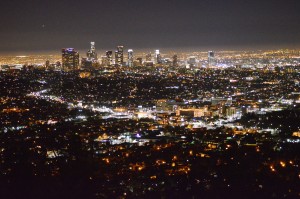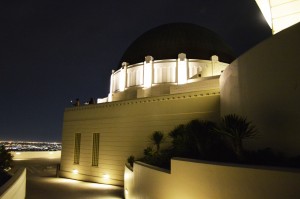LA might not be the best city for stargazing—smog and light pollution ensure that the only lights in the night sky are airplanes or fireworks—but its combination of urban sprawl and bright, snaking freeways make for a dazzling nighttime cityscape. At only thirty minutes away, one of the best places to take in the city’s luminescent landscape is Griffith Observatory
.
Located in the Hollywood Hills, the observatory is positioned to the northwest of downtown LA, oriented southwards for a total panoramic view of the downtown city center. Its front lawn is a long grassy rectangle that draws you towards the glow of the main building and the observatory’s southern end, where curved stairs and slopes spill visitors out onto balconies overlooking the LA cityscape.
LA’s massive urban sprawl is world-famous, and after seeing the city at night, it’s easy to see why. The downtown skyscrapers light up, the freeways shine with continuous headlights and the hazy lights of the city extend far into the observable horizon. The balconies are a great spot to snap photos (in close to a Facebook timeline format, no less) and the coin-operable binoculars provide a close-up view of the illuminated office buildings and bustling freeways in the distance.
The sight is picturesque, and movie studios have taken note, utilizing the observatory as a backyard shooting resource. Many movies have used the observatory as a backdrop, the most famous being James Dean’s Rebel Without a Cause. The 1955 drama put the observatory’s spacious exterior and beautiful art deco interior in the national spotlight and is commemorated by a bust of Dean on the west side of the observatory lawn.
If you’re interested in stars of a different sort, step into Griffith’s Samuel Oschin Planetarium and turn your eyes skyward. Their famous Zeiss refracting telescope, the original 12-inch stationary telescope, targets the brightest astronomical objects like the planets and moon. Another stationary solar telescope, as well as portable telescopes on the lawn, are free and available anytime the sky is clear.

Also offered is an IMAX-like show that features four different dazzling scientific programs every 60 to 90 minutes with topics ranging from the undiscovered deep cosmos to the search for water on foreign planets. Eight showing times are offered on weekdays and ten are offered on the weekend, with ticket prices ranging from $3 to $7.
The largest astronomically accurate image ever constructed is hosted here as well. Visitors can examine an incredibly detailed compiled image of the Virgo cluster, called “The Big Picture,” up close or through telescopes 60 feet away.
To cap off a night of dazzlement and discovery, you can check out the interactive exhibits in the main building or grab a snack at Griffith’s Café at the End of the Universe.
As per its founder’s wish for public accessibility, admission is free and the observatory is open Tuesday through Sunday. Weekday visiting hours are noon to 10 pm and weekend hours are 10 am to 10 pm. Come at night for maximum bedazzlement, come during daytime for expansive views.
